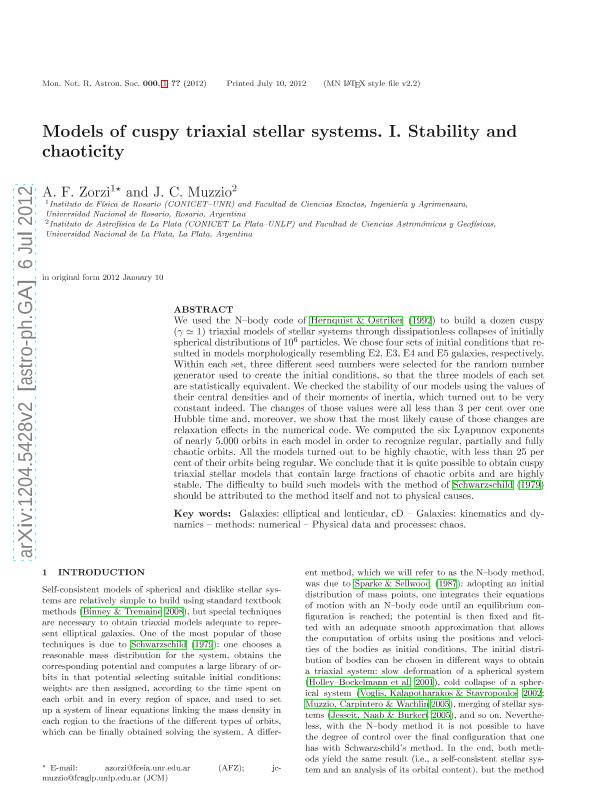Mostrar el registro sencillo del ítem
dc.contributor.author
Zorzi, Alejandra Francisca

dc.contributor.author
Muzzio, Juan Carlos

dc.date.available
2018-04-19T14:02:28Z
dc.date.issued
2012-06
dc.identifier.citation
Zorzi, Alejandra Francisca; Muzzio, Juan Carlos; Models of cuspy triaxial stellar systems, I: stability and chaoticity; Wiley Blackwell Publishing, Inc; Monthly Notices of the Royal Astronomical Society; 423; 2; 6-2012; 1955-1963
dc.identifier.issn
0035-8711
dc.identifier.uri
http://hdl.handle.net/11336/42616
dc.description.abstract
We used the N-body code ofWe used the N–body code of Hernquist & Ostriker (1992) to build a dozen cuspy (γ ≃ 1) triaxial models of stellar systems through dissipationless collapses of initially spherical distributions of 106 particles. We chose four sets of initial conditions that resulted in models morphologically resembling E2, E3, E4 and E5 galaxies, respectively. Within each set, three different seed numbers were selected for the random number generator used to create the initial conditions, so that the three models of each set are statistically equivalent. We checked the stability of our models using the values of their central densities and of their moments of inertia, which turned out to be very constant indeed. The changes of those values were all less than 3 per cent over one Hubble time and, moreover, we show that the most likely cause of those changes are relaxation effects in the numerical code. We computed the six Lyapunov exponents of nearly 5,000 orbits in each model in order to recognize regular, partially and fully chaotic orbits. All the models turned out to be highly chaotic, with less than 25 per cent of their orbits being regular. We conclude that it is quite possible to obtain cuspy triaxial stellar models that contain large fractions of chaotic orbits and are highly stable. The difficulty to build such models with the method of Schwarzschild (1979) should be attributed to the method itself and not to physical causes.
dc.format
application/pdf
dc.language.iso
eng
dc.publisher
Wiley Blackwell Publishing, Inc

dc.rights
info:eu-repo/semantics/openAccess
dc.rights.uri
https://creativecommons.org/licenses/by-nc-sa/2.5/ar/
dc.subject
Eliptical Galaxies
dc.subject
Kinematics
dc.subject
Numerical Methods
dc.subject
Physical Data
dc.subject
Chaos
dc.subject
Dynamics
dc.subject.classification
Astronomía

dc.subject.classification
Ciencias Físicas

dc.subject.classification
CIENCIAS NATURALES Y EXACTAS

dc.title
Models of cuspy triaxial stellar systems, I: stability and chaoticity
dc.type
info:eu-repo/semantics/article
dc.type
info:ar-repo/semantics/artículo
dc.type
info:eu-repo/semantics/publishedVersion
dc.date.updated
2018-04-16T14:55:29Z
dc.journal.volume
423
dc.journal.number
2
dc.journal.pagination
1955-1963
dc.journal.pais
Reino Unido

dc.journal.ciudad
Londres
dc.description.fil
Fil: Zorzi, Alejandra Francisca. Consejo Nacional de Investigaciones Científicas y Técnicas. Centro Científico Tecnológico Conicet - Rosario. Instituto de Física de Rosario. Universidad Nacional de Rosario. Instituto de Física de Rosario; Argentina
dc.description.fil
Fil: Muzzio, Juan Carlos. Consejo Nacional de Investigaciones Científicas y Técnicas. Centro Científico Tecnológico Conicet - La Plata. Instituto de Astrofísica La Plata. Universidad Nacional de La Plata. Facultad de Ciencias Astronómicas y Geofísicas. Instituto de Astrofísica La Plata; Argentina
dc.journal.title
Monthly Notices of the Royal Astronomical Society

dc.relation.alternativeid
info:eu-repo/semantics/altIdentifier/doi/http://dx.doi.org/10.1111/j.1365-2966.2012.21023.x
dc.relation.alternativeid
info:eu-repo/semantics/altIdentifier/url/https://academic.oup.com/mnras/article/423/2/1955/977019
Archivos asociados
